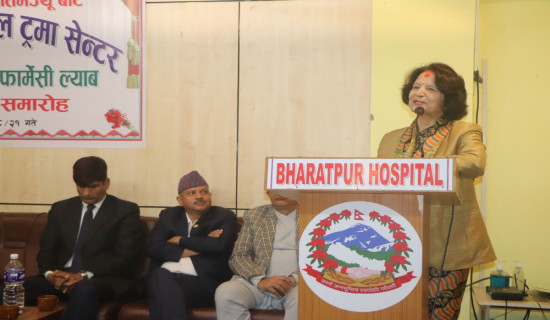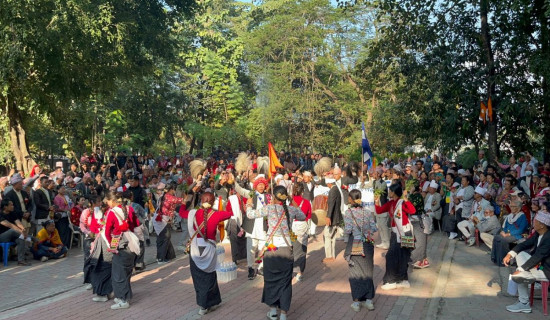- Sunday, 7 December 2025
Protect Yak Pastoralism In Himalayas
Pastoralism – a practice where domesticated animals are raised and herded in open grazing areas – has historically been an important source of subsistence and livelihoods for Himalayan mountain communities. People in Nepal herd yaks, chauri (yak-cow hybrids), sheep, and goats. Yak and chauri herders practice transhumance pastoralism, moving their herds seasonally to pastures at different altitudes. However, transhumance pastoralism has been on the decline for decades. The reasons for this include outmigration, changes in land tenure due to government policy, the establishment of conservation areas, and shifting social values.
Climate change is also altering the fragile ecology of high-altitude rangelands, with erratic weather patterns and increased incidence of extreme events. This age-old practice is going through profound transformations. While some areas are witnessing a dramatic decline, other areas are seeing an unexpected revival. The case of Rasuwa District in north-central Nepal, particularly in the Himalayan communities of Langtang and Gatlang, presents a study in contrasts.
Dwindling herders
In Langtang, the number of yak herders has dwindled from 50–60 to a mere four over the past decade, especially after the 2015 earthquake, which not only destroyed many homes but also resulted in the loss of a significant number of yaks. This decline reflects the broader challenges, including climate change, shrinking pasturelands, increasing economic alternatives, and shifting societal aspirations that pastoralism is facing. Younger generations are opting for urban-based employment or migrating abroad, leaving traditional livelihoods vulnerable to extinction and making the older generation worried.
‘Yak is our identity. Without yak, our culture will disappear,’ says Tenjin Lama, herder and chairman of the local herders committee in Langtang. His words echo the growing anxiety felt across high mountain communities, where traditional pastoralist livelihoods are under increasing threat. In the Himalaya, yak herding is more than a livelihood; it is a way of life, interwoven with local identity, rituals, and resilience. But today, this centuries-old tradition is at risk. The availability of winter fodder is shrinking due to changing weather patterns and degraded rangelands. With limited grazing and fodder options, many herders are being forced to reduce their herd size or abandon herding altogether. “If there are no yaks, it’s not just an economic loss. We lose a whole culture, a whole way of living,” says Lama.
Even for those who continue to herd, the challenges are mounting. The price of milk remains low. Value-added products like ghee and cheese, once symbols of Himalayan prosperity, are not fetching fair prices. “Without a functioning cheese factory, even tourism will suffer,” Lama warns. “Visitors come not only for the breathtaking views, but to experience yak herding culture, to see these majestic animals, and taste our traditional cheese.” The growing issue of pollution, especially plastic waste along trekking routes, is compounding the problem. Yaks and chauri often feed on litter scattered across pastures, posing serious risks to their health. Veterinary services in these remote areas remain inadequate.
Tenjin Lama’s call is clear: pastoralist communities need urgent support for improved fodder management, better veterinary services, and fair pricing mechanisms to keep the cheese factories running. “We are custodians of the high mountains,” he says, “but we cannot protect this heritage alone. We need the support of local government and civil society. Because when yaks disappear, a whole mountain culture disappears with them.” Conversely, in the village of Gatlang, the number of yak and chauri herders has doubled over the last decade, growing from 22 to 52. This revival suggests that under the right conditions, pastoralism remains viable and even attractive.
Several factors might be at play here, such as improved market access, government incentives, or local recognition of the cultural and economic value of herding. It also signals that pastoralism, rather than being a relic of the past, can adapt to changing conditions and modern needs. Around 7–8 yak herders who had migrated to Gulf countries chose to return, as they found themselves engaged in a similar type of work abroad and ultimately decided to resume their traditional herding profession.
Despite this recent increase in yak and chauri herders in Gatlang, herders face many challenges. Migma Sonan Tamang, chair of the Rangelands Management Cooperative and a dedicated herder from Gatlang, has been instrumental in inspiring local youth to return to traditional herding practices. He says access to high-altitude pastures remains a significant barrier due to the absence of proper roads and infrastructure. There are other pressing issues: pasture degradation caused by invasive plant species and weeds locally known as Paldonge and Domja, encroachment by woody shrubs, and water scarcity. Migma and other herders believe that a well-designed programme focused on pasture restoration, particularly through ecologically sound methods like prescribed burning, could significantly improve forage quality and availability.
Sustainable management
Importantly, local herders are willing to contribute their time, knowledge, and labour toward the restoration and sustainable management of rangelands. The diverging trajectories of Langtang and Gatlang offer critical lessons. Policies should focus on addressing the root causes of pastoral decline while fostering conditions for sustainable herding. Strengthening access to grazing lands, improving veterinary services, and enhancing market linkages can help revitalise the sector. Recognising pastoralists’ rights and integrating traditional knowledge with contemporary practices will be key to ensuring the long-term sustainability of transhumant pastoralism.
If pastoralism is to survive and thrive in Nepal, it needs strategic interventions, community engagement, and adaptive policies that are responsive to the evolving needs of Himalayan herders. By learning from both decline and revival, we can craft a future where pastoralism remains a resilient and dynamic part of Nepal’s highland economy and culture. In recognition of the cultural and ecological value of yaks, the Nepal government has declared 20 April as National Yak Day. This symbolic gesture also underscores the urgent need to support yak herders and conserve mountain livelihoods.
(Joshi is an ecosystem specialist at the International Centre for Integrated Mountain Development (ICIMOD). Sanjyal is a scientist at the National Pasture and Fodder Research Centre, NARC.)

















